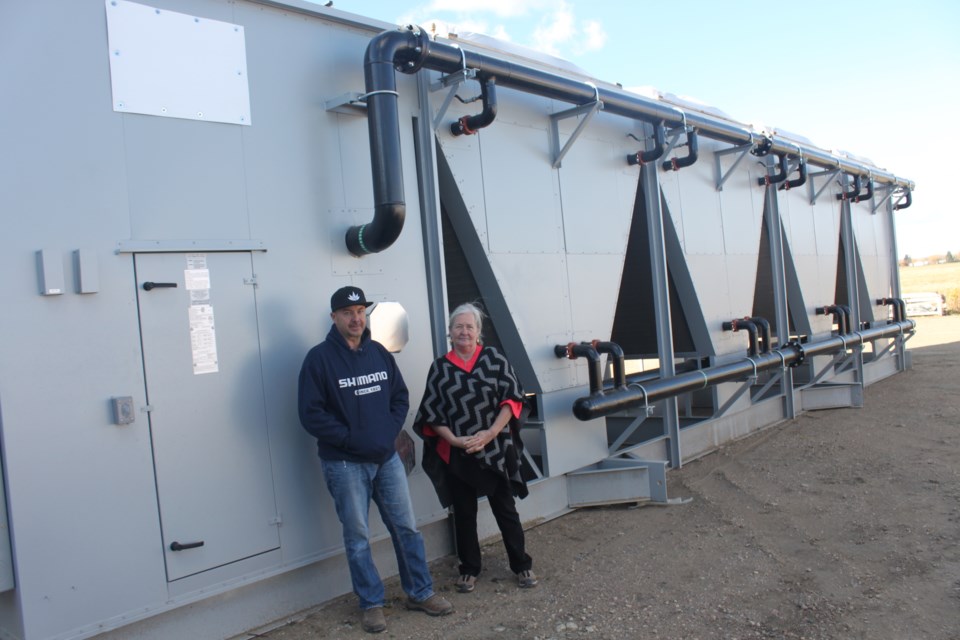ST. PAUL - A 30,000 square foot space in St. Paul’s industrial subdivision is slowly but surely being transformed into a high-tech marijuana grow operation to supply products to the pharmaceutical market.
It’s been more than two years since Central Prairie Pharmaceuticals first announced its intention to open up shop in the community. Since that time the company has been navigating construction hurdles and stringent Health Canada regulations as it works to complete the building phase and move into the growing and production phase of the business. But then came the pandemic, which has served up its own set of challenges as the new business strives to get off the ground.
Project manager Dave Doonanco and financial officer Joanne Penner guided Lakeland This Week through a labyrinth of under-construction growing, drying, trimming, storage, processing and packaging rooms last Tuesday, explaining the complex and highly technical process of growing marijuana for pharmaceutical use. As they explain the intricate workings of this grow op, it quickly becomes clear this is no small undertaking.
“I didn’t know how this all worked either when we started pouring concrete,” Doonanco admits. He said the learning curve for everyone involved has been steep, there’s been some sleepless nights and the work is far from over. But with their eye on the prize, the entrepreneurs remain focused on getting it right.
“The HVAC system we have here is phenomenal. Every single grow room has its own dedicated unit that controls the atmosphere. Our engineers are excited because it’s sort of a Gen-4 design,” he said explaining the complexity of ensuring growing conditions are just right for the plants through the various stages of development.
The system the engineers have devised, together with their master grower, is the only one of its kind in the world, Doonanco says.
“What a lot of facilities are having problems with is the moisture. When you drop the temperature, naturally condensation (forms), then it gets on the plants and you have mould. With the system they have designed, there’s another feature to it to draw out the moisture,” he explains. “It’s almost like a centrifuge where it draws the moisture out of the air, chills it, condensates it and fires the air back in without the moisture so you can drop your heat levels.” As the plants grow they require different amounts of humidity at different stages in different situations. The issue is trying to get the humidity out without it staying on the plants, he says.
The company’s master grower is already developing “mother plants” offsite which will be the source of genetics for all the crops going forward. Penner describes them as the “queen bees” from which everything else flows. They’ve sourced high quality seeds from around the world for this enterprise.
“There will be a mothering room that will be strictly our mother plants – so it’s all different types of genetics and then you get the clone from them, you plant the clone and that’s what you grow your actual crop from,” Penner says. Her enthusiasm and excitement for what the company is pursuing is obvious as she explains the process.
Unlike large-scale cannabis companies like Aurora Cannabis, which also supplies product to the medical market, Penner says Central Prairie Pharmaceuticals has a much more controlled environment due to its small scale.
“We have decided to take more of a micro-grower approach to it because you produce a better quality product in a much, much more sealed and contained environment. That was why the decision to go this way, because the product quality that we produce will be second to none.”
Doonanco says the company’s master grower is “big on organic” and they all agree it’s the way of the future.
“Everything he does is organic soils, organic mixtures. The processing end of it will be done in the same fashion. He doesn’t nuke stuff, he doesn’t use chemicals, there’s no additives.”
“Everything that touches those plants or has anything to do with the final product is certified organic,” Penner adds.
So, what do the timelines look like between finishing up the construction phase to moving the mother plants into the facility and harvesting their first crop?
Best case scenario they say is to complete the building by the end of the year and have plants growing in the facility by early 2021. But as is the case with everything in 2020, the supply chain has been impacted by the pandemic and so a lot is dependent on acquiring all the pieces needed for the construction finishing stages.
Once the construction phase is complete, Doonanco says they will have to provide Health Canada with an evidence package detailing everything from security features, internal operating procedures and finishing materials to air quality. From there, Health Canada has a couple of months to review and sign off on it. After that, samples from the first two test crops will have to also be approved at the federal level again in order to sell.
The finished products, which will include dried flower buds, oils (THC, THCA, CBD), rosins and concentrate for edibles will be sold into the pharmaceutical market through distributors including Alberta Gaming, Liquor and Cannabis (AGLC), and also online.
“We hope to have a big online presence but they will all be pharmaceutical use customers because that is the law in the country,” Penner says, adding the medical market has always been the vision for the company.
There’s a lot riding on this new enterprise, investment easily north of $10 million and growing, no pun intended. They declined to put a firm number to the price tag at this point.
Doonanco gets the credit from Penner for saying at some point as they were looking at how to repurpose the building and business interests, following the collapse in the energy sector, “What would you guys think about cannabis? From that day forward, we haven’t looked back.”



